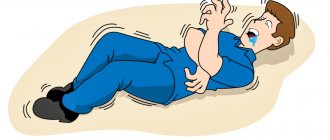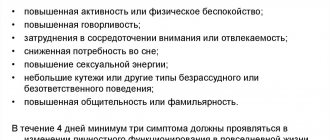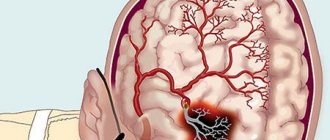Psychotic depression is an acute mental disorder that is characterized by depressive tendencies and signs of psychosis. Symptoms of a psychotic disorder also include hallucinations, delusions, confusion, altered perceptions, and depressive tendencies.
A person suffering from psychotic depression loses the ability to think clearly and clearly, to perceive the real world and his actions as they are. The patient may hear verbal hallucinations in the form of one or several voices, which are very difficult to get rid of. Visual hallucinations in the form of silhouettes of people and animals also occur. Crazy and strange ideas constantly accompany a person, destroying him from the inside. He may have the feeling that everything that happens is staged events (the patient believes that everything that happens is arranged on purpose, for some purpose). Communication with such a person becomes impossible, because his speech has no logic or consistency, so patients spend most of their time alone.
Psychotic depression differs from other depressive disorders in that a person is aware of the illogicality of his thoughts and desires, understands that he is sick and needs help. The patient realizes the unnaturalness and illogicality of his feelings and thoughts. During a period of illness, a person feels inferior and tries to hide her ideas and desires from others. Ignoring and hiding your thoughts and feelings complicates the diagnosis of the disease, which is the main factor in recovery and alleviation of the patient’s condition.
The clinical picture of this disorder contains psychological components, which most often are not the main, but additional components. For example, the patient may exhibit either hallucinations or delusional and obsessive ideas.
The risk of this disease is that over time, psychotic depression can develop into bipolar disorder, which is much more difficult to cure. Bipolar disorder is characterized not only by sudden changes in mood, but also often makes the patient want to commit suicide or harm himself.
It is necessary to learn to distinguish this disorder from schizophrenia, since these two diseases have similar symptoms. Psychotic depression manifests itself in the form of a depressed, depressed mood, disorientation of a person, a feeling of inferiority and hallucinations, which are perceived by the patient as unreal visions (the person is clearly aware that what he saw or heard is fiction and does not perceive it as real events).
How is it different from laziness and depression?
How do you know if you have apathy?
when you don't feel like washing the dishes because you just don't like doing it, that's laziness
if you cannot pull yourself together and do the usual things that you could easily do at any other time, this already looks like apathy
- ; (@yericassoo) July 21, 2020
apathy and depression: what is the difference?
Depression is not just a bad mood, but a serious illness that affects your physical and mental health
apathy is not depression yet, but the condition is very close. in general, it is absolutely normal if it lasts 1-3 days
- ; (@yericassoo) July 21, 2020
Apathy and depression can be both signs of Common and Different Features Between Depression and Apathy in Neurocognitive Disorders of one disorder, and independent syndromes Apathy Is Not Depression. Simply put, the presence of apathy does not mean you are depressed, but this condition cannot be triggered. If you cannot cope on your own, be sure to consult a doctor.
Causes and risk factors
There are several reasons for the development of the disease.
Most often, pathology is recorded in people with a hereditary predisposition. In 80% of cases, one or both parents of the patient also suffered from this disorder, prolonged depression or psychopathological disorders.
There is also a biological theory of the problem. Experts suggest that brain function is disrupted due to an insufficient amount of substances necessary to regulate the emotional state.
There is most often no connection with psychological trauma. But traumatic situations can cause the condition to worsen and the symptoms to worsen.
What are the symptoms?
but the state of apathy is also characterized by a violation of the emotional-volitional sphere, and first of all, a person manifests unemotionality
for example, you give up and drop an expensive cup given to you by your loved one, but you don’t react in any way
- ; (@yericassoo) July 21, 2020
signs and symptoms of apathy:
• indifference to what is happening in life • emotional lethargy • decreased activity • desire to withdraw from society • laziness • drowsiness • loss of interest in simple everyday joys • loss of appetite
- ; (@yericassoo) July 21, 2020
According to Pain and apathy research, in some cases apathy can be the cause of pain syndromes.
The most common type of pain is headache; disturbances in the functioning of the gastrointestinal tract are also observed
- ; (@yericassoo) July 21, 2020
What to do if you have apathy
1. basic care starts with the body
sleep and rest routine - do you do it, or do you stay up late? do you get enough sleep?
it seems so self-evident that many simply do not take this factor into account. Meanwhile, healthy sleep is the basis for the body’s recovery
- ; (@yericassoo) July 21, 2020
2. are you moving enough?
movement is the body's way of coping with stress
3. food
try to give up the habit of eating in front of the TV, try to eat with pleasure. this way you will fill not only your stomach, but also your internal energy resources
- ; (@yericassoo) July 21, 2020
4. Perception training
try to notice what you like in people and events. if you manage to focus on something pleasant around you, it triggers new neural connections in the brain and opens up the internal resources of the psyche
- ; (@yericassoo) July 21, 2020
5. practice small steps
when you give up and have little strength, it is important to set yourself small, realistic goals and achieve them
Don't plan too much! scientists have proven: a person who overloads his plan accomplishes much less than one who plans little
- ; (@yericassoo) July 21, 2020
6. Start with self-compassion and accept your condition.
At this time, the best thing to do is to admit that you have this condition. and you are not lazy, not unscrupulous, but a person who is exhausted and needs a reboot
- ; (@yericassoo) July 21, 2020
7. analysis
determine what exactly preceded your apathy. By identifying the reasons, you can at least hypothetically change the situation
- ; (@yericassoo) July 21, 2020
8. communicate
try to communicate more with different people. man is a social being. It is logical that in the absence of communication, indifference and isolation appear
but here you need to know when to stop: if you are physically or mentally exhausted, it is better to sleep and take time for yourself
- ; (@yericassoo) July 21, 2020
9. watching movies and listening to music has not been canceled
10. try experimenting with your image
11. finding a hobby
- ; (@yericassoo) July 21, 2020
If you are not yet mired in the swamp of complete apathy, then you can easily cope with this condition on your own, but if this feeling continues for more than 3 weeks, then it is better to consult a specialist and there is nothing shameful in this ((take care of yourself!
- ; (@yericassoo) July 21, 2020
G.E. Maso
St. Petersburg Psychoneurological Research Institute named after. V.M. Bekhterev
SUMMARY The review comprehensively examines the problem: is psychotic depression an independent disease? "Depression with psychotic symptoms" or "psychotic depression" is traditionally classified in the ICD-10 and DSM-4 as a subtype of depressive disorder. However, all the data presented in the review, as the author himself notes, is still not enough to give an unambiguous answer to this question.
Introduction “Depression with psychotic symptoms” or “Psychotic depression” is traditionally considered a subtype of depressive disorder in the ICD-10 and DSM-4 classifications. In modern scientific literature, there is an established view of this pathology as severe, poorly diagnosed and associated with a high risk of suicide. Thus, a retrospective analysis of patients hospitalized for depressive disorder showed that in the group of patients with psychotic symptoms, suicide attempts are registered 5 times more often [40], and mortality is 2 times higher than in the group with non-psychotic depression [51]. Moreover, mortality largely depends on age, comorbid somatic diseases and is not associated with cases of suicide attempts. Psychotic depression is a common pathology. In an epidemiological study of a population of patients with recurrent depressive disorder, 14.7% had episodes with psychotic symptoms [22]; when assessing patients receiving inpatient treatment for depressive disorder – in 25-45% [49]; in patients of older age groups suffering from depression – in 45% of cases [32]. Recent studies conducted in 5 European countries showed that in a survey of the general population, 2.4% met criteria for a depressive disorder, of which 19% had depression classified as psychotic. According to these data, the prevalence of psychotic depression is 0.4% [36]. Psychotic disorders are often reported among patients considered treatment-resistant [17]. This can also be explained by diagnostic errors in the assessment of psychotic depression [43], which entails inadequate therapeutic approaches. The reason for the low recognition of psychotic symptoms in depression lies in a number of circumstances:
• Difficulties in differential diagnosis of psychotic depression with disorders occurring within the framework of schizophrenic psychoses [23]. • Psychotic disorders in depression may be subtle, intermittent, or hidden by patients [42]. In these cases, the most common diagnosis is an episode of recurrent depression without psychotic symptoms. • Severe psychomotor retardation, characteristic of this group of patients, may mask psychotic symptoms [37]. • Difficulties in making a differential diagnosis in patients with Itsenko-Cushing's disease [8]. • According to the ICD-10 classification, psychotic symptoms can be recorded in severe depressive episodes, while studies in recent years show the possibility of the presence of psychotic symptoms in mild and moderate depression. • Terminological inaccuracies, which manifested themselves more clearly in Russian psychiatry. The term "psychotic depression" has traditionally been synonymous with "endogenous depression" and is contrasted with "neurotic depression". Only in a narrower sense was psychotic depression defined as “delusional melancholia” [2].
There has long been a debate in the scientific literature: whether psychotic depression is a special subtype of depressive disorder or whether the main differences are reduced only to greater severity of symptoms. Data obtained in recent years have allowed a number of authors to say that when classifying depression, it is advisable to distinguish “Psychotic depression” as an independent disorder [24], just as schizoaffective psychosis is separated from schizophrenia. This division is given important theoretical and practical significance, since there is reason to assume that psychotic depression and depression without psychotic symptoms are two independent disorders with different biological essences [42]. To assess psychotic depression as an independent disease, the following grounds are distinguished:
1. Genetic factors. 2. Clinical characteristics. 3. Neuroendocrine profile.
Genetic factors Research into the specificity of hereditary burden of psychotic depression has been conducted since the 80s of the last century, when B. Prusoff et al. [39] proposed a hypothesis: if psychotic depression is an independent disease, then different risks of depression in relatives of patients with psychotic and non-psychotic forms should be recorded. At the same time, studies were published showing that relatives of patients with psychotic depression have a greater risk of developing depression than in the case of non-psychotic depression, and more often suffer from the psychotic form of the disease [26]. Other work in this direction has demonstrated a more frequent hereditary burden of schizophrenia [11] and bipolar disorder [53] in patients with psychotic depression. Thus, studies of the 80s of the last century on the study of hereditary burden in psychotic depression largely indicated possible genetic differences when compared with non-psychotic forms of the disease, but the results on the problems studied were contradictory. The review by M. Tsuang [50] indicates that research in this direction has not been conducted in recent years. Genetic studies aimed at identifying connections between certain chromosomes and psychotic depression also do not make it possible to confidently speak about the genetic specificity of psychotic depression. The possible connection between psychotic depression and chromosome 11 has been discussed [27], but these data have not been confirmed in other studies [33]. Modern publications largely discuss the involvement of the same loci that are considered in recurrent depression and bipolar disorder, which makes the question of the genetic specificity of psychotic depression somewhat controversial. Another approach in genetic research is association studies aimed at identifying the characteristics of genes encoding neurochemical activity in structures that are interested in the formation of the disease. With this approach for affective disorder, attention is paid to the genes encoding the synthesis of serotonin and dopamine receptors and the transporters of these mediators. In this direction, the gene encoding the D4 receptor, the polymorphism of which is determined in various psychotic conditions, is most often discussed in psychotic forms of depression [50]. Thus, modern genetic studies contain data most likely indicating the heterogeneity of psychotic depression and possible affinity with schizophrenia spectrum diseases.
Clinical characteristics of psychotic depression Researchers suggest that in addition to the actual psychotic symptoms, such as delusions and hallucinations, there are specific clinical manifestations that are more characteristic of psychotic depression. First of all, this relates to the general severity of depressive symptoms. Psychotic depression is a more severe illness, and, as a consequence, a higher level of depressive symptoms is recorded in this group of patients, as stated in most scientific publications [1, 29, 41]. Indeed, as the severity of depressive symptoms increases, the likelihood of developing psychotic disorders also increases. However, there is evidence of delusions and hallucinations in patients with depressive episodes classified as mild to moderate [36], while severe depressive episodes may occur without psychotic symptoms. Thus, the severity of painful manifestations alone is not a guideline for psychotic depression. However, according to ICD-10, psychotic symptoms in the structure of a depressive episode can only be registered in the case of a severe depressive episode. Another direction is the identification of specific depressive symptoms, which are more present in psychotic depression. These include psychomotor disorders, including both retardation and agitation [7, 29]. Other authors suggest that the high level of depressive symptoms in psychotic depression is associated with a greater prevalence of inhibition associated with cognitive impairment [41]. Studies of cognitive functioning in patients with psychotic depression provide convincing evidence of a more pronounced decline in key indicators compared to other subtypes of depression [20]. Based on a meta-review of studies, the most convincing evidence was obtained for verbal memory, executive functions and psychomotor speed [18]. Moreover, the severity of cognitive impairment depends to a small extent on the number of episodes experienced, since it is determined in patients with the first episode of psychotic depression [21]. After successful treatment of patients with psychotic depression, cognitive performance tends to improve [20]. It must be recognized that psychomotor disorders are currently considered one of the leading symptoms of psychotic depression, but there are also a variety of other disorders, the severity of which is higher in psychotic depression. These include: absence of fluctuations in mood during the day [37]; more pronounced, compared with non-psychotic depressive disorders, hypochondria, anxiety, guilt, difficulty falling asleep, and stool retention. A recently published study by J. Keller et al. [23] compared the severity of depressive symptoms based on the Hamilton Depression Scale-21 in psychotic and non-psychotic depression. The study included patients with varying severity of depressive episodes in both psychotic and non-psychotic depression. According to the authors, this approach made it possible to exclude the influence of the overall level of depression on the severity of individual symptoms. Evidence has been obtained of a greater prevalence in patients with psychotic depression, primarily of lethargy and feelings of guilt. Thus, an analysis of studies aimed at identifying painful symptoms that are higher in psychotic depression provides very diverse data regarding a wide range of depressive manifestations. Probably, the results of developments undertaken in this direction are significantly determined by methodological differences during the work. At the same time, the identification of symptoms such as psychomotor disturbances and feelings of guilt makes it possible to consider, in cases of their pronounced representation in the picture of the disease, as a probabilistic predictor of the development of psychotic depression. The course of depressive episodes in patients with psychotic depression has its own characteristics. These patients are characterized by a protracted course of depressive episodes [30] and a tendency to repeat psychotic manifestations in the structure of subsequent episodes [47]. Prognostically, a history of psychotic depression is considered to be an unfavorable factor for the course of the disease. It is believed that patients with psychotic depression are more prone to recurrent depressive episodes throughout life [5], although this fact is not confirmed in a number of studies [10, 28]. It cannot be excluded that when assessing the effect of psychotic depression on the prognosis, the duration of observation is important. Thus, during a 10-year observation [30] of patients who had suffered a depressive episode, it was revealed that the presence of psychotic symptoms negatively affects the short-term prognosis, and, to a lesser extent, affects more distant stages of the disease. In this study, no worse psychopathological and psychosocial response was recorded at the end of the ten-year follow-up period. These data confirm the results of an earlier longitudinal prospective study, which showed that the adverse prognostic value of a previous episode of depression with psychotic symptoms decreases over time [12].
Neuroendocrine profile of psychotic depression Research on pathophysiological abnormalities in endogenous depression has focused on hyperactivity of the hypothalamic-pituitary-adrenal (HPA) axis, and these dysfunctions are significantly more determined in psychotic than in non-psychotic depression [9, 35]. Many studies describe that patients with psychotic depression are more likely to fail to respond to the dexamethasone test than patients with non-psychotic depression [35, 46, 48]. The dexamethasone test has low sensitivity and specificity for depression, but it has been suggested that the use of this test is more informative in differentiating psychotic and melancholic depression from other subtypes of this disorder [38]. A meta-analysis of 12 studies involving 1000 patients, which did not include patients with melancholic depression, showed that cases of psychotic depression were more likely to show a lack of cortisol suppression in the dexamethasone test [35]. Moreover, hyperactivity of the HPA system in cases of psychotic depression did not have a pronounced correlation with the overall severity of the depressive state and was found in patients with non-severe depression. The clinical features of psychotic depression are associated with the participation of disturbances in dopamine transmission in the pathogenesis. Many studies indicate activation of the dopamine system in psychotic depression [16] and an increase in dopamine metabolites in the cerebrospinal fluid [3], while this is not typical for patients with non-psychotic depression. AJ Rothschild et al. [43], in a study comparing patients with psychotic and non-psychotic depression and healthy controls, reported an increase in serum dopamine, a decrease in norepinephrine and an increase in cortisol levels in the group of patients with psychotic depression compared with the alternative two groups. It is assumed that the increase in dopamine levels is secondary and is caused by increased cortisol levels, which leads to the development of psychotic symptoms in the structure of a depressive episode [48]. Another direction in analyzing the causes of the clinical uniqueness of psychotic depression is the study of the activity of the enzyme dopamine beta-hydroxylase (DBH), which converts dopamine into norepinephrine. In patients with psychotic depression, the level of DBH activity is lower than in patients with unipolar non-psychotic depression [34], schizophrenia and in the healthy control group [31]. A low level of DBH activity is considered as a potential marker that clearly indicates an increase in dopamine levels under conditions of prolonged exposure to high cortisol levels [48]. It is assumed that differences in the activity of DBG in patients with psychotic and non-psychotic depression may be determined by genetic factors, neurobiological and neuroendocrine features of these conditions and other non-heritable reasons (age, drugs used, etc.). For example, the activity of the DBC decreases with age, and in older patients the risk of developing psychotic depression increases. The authors do not exclude that the level of DBG activity cannot be determined by only one of the listed factors and depends on the interaction of many mechanisms [14]. The result of decreased DBG expression is a decrease in the conversion of dopamine to norepinephrine. This leads to an increase in dopamine levels in areas such as the frontal cortex, which is rich in noradrenergic and dopaminergic receptors. The functional interaction between noradrenergic and dopaminergic mechanisms contributes to the development of neurocognitive disorders that play a role in the development of psychotic symptoms [6].
Discussion The identification of psychotic depression as an independent type of depressive disorder is currently controversial. The high hopes that were placed on genetic research were not justified, as they showed conflicting results. The identification of specific clinical characteristics, in addition to the actual psychotic manifestations, in psychotic depression made it possible to identify a number of symptoms, such as psychomotor and cognitive impairment and feelings of guilt. But these manifestations can also be presented in the clinical picture of non-psychotic depression. Therefore, their assessment, even when using psychometric tools, can only be carried out according to the principles of “more - less”, “less often - more often” and significantly depends on the research methodology. The most convincing fact suggesting the nosological independence of psychotic depression is its neuroendocrine profile. First of all, this is the hypothesis put forward in 1985 by AF Schatzberg et al. [48], suggesting that the appearance of psychotic symptoms during a depressive episode may be due to increased activity of the mesolimbic and mesocortical dopamine systems stimulated by the HPA axis. Interest in this is also reinforced by the fact that the severity of dysfunction in the HPA system partially explains the clinical features of depression with psychotic symptoms. There is evidence that in the group of patients with non-psychotic depression, normalization of indicators of the functioning of the HPA system occurs during therapy [25], while in patients with psychotic depression, during therapy the level of cortisol and ACTH remains elevated [19] and persists in periods between exacerbations depression [13, 52]. These facts, first of all, may indicate more pronounced and persistent dysfunction in the HPA system in patients with psychotic depression. Hyperfunction of the HPA system that persists during therapy can influence the course of the disease. This is confirmed by data indicating the negative impact of hypercortisolemia on the risk of recurrence of depressive conditions and an increase in the frequency of depressive episodes [4]. Thus, there is now evidence to draw parallels between HPA axis dysfunction and the course of depression with psychotic symptoms. Probably, the participation of HPA axis dysfunction in the development of psychotic depression may also be evidenced by neurological changes that are recorded with a long-term increase in cortisol levels (cortical atrophy, enlargement of the ventricles of the brain, reduction of the hippocampus). Similar changes are recorded in neuroimaging studies in patients with psychotic depression [44]. Thus, there is evidence to suggest the existence of a distinct neuroendocrine profile of depression with psychotic symptoms. There is currently discussion about the possibility of including biological markers as diagnostic criteria for depressive disorder in new diagnostic manuals such as DSM-V and ICD-11. However, the report of the WFSBP Special Commission on the Study of Biological Markers for Depression, published in 2007, shows that currently none of the markers discussed can be used as a diagnostic test. At the same time, the authors do not exclude that at the present stage, identifying biological markers, first of all, may be useful for identifying a certain type of depression. Probably, the data presented are not enough to consider psychotic depression as an independent disease, since one important factor is missing here - the specificity of the therapeutic response. It is known that modern management of such patients includes the combined use of antipsychotics and antidepressants, although this approach is also widely used in the treatment of depression without psychotic symptoms. But it is of interest to discuss the possibility of using drugs that are glucocorticoid antagonists to treat psychotic depression [15, 45]. Perhaps research in this direction will allow us to get closer to answering the question of whether psychotic depression is an independent disease.
Literature 1. Vovin R.Ya., Aksenova I.O. Prolonged depression. L.: Medicine, 1982; 18. 2. Mosolov S.N. Clinical use of modern antidepressants. St. Petersburg: Medical Information Agency, 1995; 568. 3. Aberg-Wistedt A., Wistedt B., Bertilsson L. Higher CSF levels of HVA and 5-HIAA in delusional compared to non delusional depression // Arch Gen Psychiatry.1985; 42: 925-926. 4. Appelhof BC, Huyser J., Verweij M., Brouwer JP, van Dyck R., Fliers E., Hoogendijk WJ, Tijssen JG, Wiersinga WM, Schene AH Glucocorticoids and relapse of major depression (dexamethasone/corticotropin-releasing hormone test in relation to relapse of major depression) // Biol. Psychiatry. 2006; 59: 696-701. 5. Aronson T.A., Shukla S., Gujavarty K., Hoff A., DiBuono M., Khan E. Relapse in delusional depression: a retrospective study of the course of treatment // Compr Psychiatry.1988; 29: 12-21. 6. Birnbaum S., Gobeske KT, Auerbach J., Taylor JR, Arnsten AF A role for norepinephrine in stress-induced cognitive deficits: a-1-adrenoceptor mediation in the prefrontal cortex // Biol Psychiatry. 1999; 46: 1266-1274. 7. Charney DS, Nelson JC Delusional and nondelusional unipolar depression: further evidence for distinct subtypes // Am J Psychiatry. 1981; 138: 328-333. 8. Chu JW, Matthias DF, Belanoff J. et al. Successful long-term treatment of refractory Cushing's disease with high dose mifepristone (RU 486) // J Clin Endocrinol Metab. 2001; 86:8:3568-73. 9. Contreras F., Menchon JM, Urretavizcaya M., et al. Hormonal differences between psychotic and non-psychotic melancholic depression // J. Affect. Discord. 2007; 100: 65-73. 10. Coryell W., Endicott J., Keller M. The importance of psychotic features to major depression: Course and outcome during a 2-year follow-up // Acta Psychiatr Scand.1987; 75: 78-85. 11. Coryell W., Lavori P., Endicott J., Keller M., VanEerdewegh M. Outcome in schizoaffective, psychotic, and nonpsychotic depression. Course during a six- to 24-month follow-up // Arch Gen Psychiatry. 1984; 41: 787-91. 12. Coryell W., Tsuang MT, McDaniel J. Psychotic features in major depression: is mood congruence important? //J Affect Disor.1982; 4: 227-37. 13. Coryell W., Fiedorowicz J., Zimmerman M., Young. EHPA-axis hyperactivity and mortality in psychotic depressive disorder: Preliminary findings // Psychoneuroendocrinology. 2008; 33: 654-658. 14. Cubells JF, Price LH, Meyers BS et al. Genotype-Controlled Analysis of Plasma Dopamine P-Hydroxylase Activity in Psychotic Unipolar Major Depression // Biol Psychiatry. 2002; 51: 358-364. 15. DeBattista C., Belanoff J., Glass S., Khan A., Horne RL, Blasey C., Carpenter LL, Alva G. Mifepristone versus placebo in the treatment of psychosis in patients with psychotic major depression. Biol. Psychiatry 2006; 60: 1343-1349. 16. Devanand DP, Bowers MB, Hoffman FJ Jr, Nelson JC Elevated homovanillic acid in depressed women with melancholia and psychosis // Psychiatry Res. 1985; 15:1-4. 17. Dubovsky SL What we don't know about psychotic depression // Biol Psychiatry. 1991; 30: 6: 533-6. 18. Fleming SK, Blasey C., Schatzberg AF Neuropsychological correlates of psychotic features in major depressive disorders: a review and meta-analysis // J Psychiatric Res. 38: 27-35. 19. Frieboes RM, Sonntag A., Yassouridis A., Eap CB, Baumann P., Steiger A. Clinical outcome after trimipramine in patients with delusional depression—a pilot study // Pharmacop-sychiatry. 2003; 36: 12-17. 20. Gomez RG, Fleming SH et al. (2006) The Neuropsychological Profile of Psychotic Major Depression and its Relation to Cortisol // Biol Psychiatry. 2006; 60: 472-478. 21. Hill SK, Keshavan MS, Thase ME, Sweeney JA Neuropsychological Dysfunction in Antipsychotic-Naive First-Episode Unipolar Psychotic Depression // Am J Psychiatry. 2004; 161:996-1003. 22. Johnson J., Horwath E., Weissman MM The validity of major depression with psychotic features based on a community sample // Arch Gen Psychiatry. 1991; 48: 1075-1081. 23. Keller J, Gomez RG, Kenna HA et al. Detecting psychotic major depression using psychiatric rating scales // J Psychiatr Res. 2006; 40: 22-29. 24. Keller J., Schatzberg AF, Maj M. Current Issues in the Classification of Psychotic Major Depression // Schizophr Bull. 2007; 33:4:877-885. 25. Kunzel HE, Binder EB, Nickel T., Ising M., Fuchs B., Majer M., Pfennig A., Ernst G., Kern N., Schmid DA, Uhr M., Holsboer F., Modell S. Pharmacological and nonpharmacological factors influencing hypothalamic-pituitary-adrenocortical axis reactivity in acutely depressed psychiatric in-patients, measured by the Dex~CRH test // Neuropsychopharmacology. 2003; 28: 2169-2178. 26. Leckman JF, Weisman MM, Prusoff BA et al. Subtypes of depression: Family study perspective // Arch Gen Psychiatry. 1984; 41: 833-838. 27. Lim LCC, Gurling H, Curtis D et al. Linkage between tyrosine hydroxylase gene and affective disorder cannot be excluded in two of six pedigrees // Am J Med Genet (Neuropsychiat Genet). 1993; 48: 223-8. 28. Lykouras E., Christodoulou GN, Malliaras D., Stefanis C. The prognostic importance of delusions in depression: A 6-year prospective follow-up study // J Affect Disord. 1994; 32: 233-238. 29. Lykouras E., Malliaras D., Christodoulou GN et al. Delusional depression: phenomenology and response to treatment: a prospective study // Acta Psychiatr Scand. 1986; 73: 324-329. 30. Maj M., Pirozzi R., Magliano L., Fiorillo A., Bartoli L. Phenomenology and prognostic significance of delusions in major depressive disorder: a 10-year follow-up study. J Clin Psychiatry. 2007; Sep; 68:9:1411-7. 31. Meltzer HY, Hyong HW, Carroll BJ, Russo P. Serum dopamine-(3-hydroxylase in the affective psychoses and schizophrenia: Decreased activity in unipolar psychotically depressed patients // Arch Gen Psychiatry. 1976; 33: 585-591. 32 Meyers BS, Greenberg R. Late-life delusional depression // J Affect Disord. 1986; 11: 133-137. 33. Mitchell P., Waters B., Morrison N. et al. Close linkage of bipolar disorder to chromosome 11 markers are excluded in two large Australian pedigrees // J Affect Disor. 1991; 21: 23-32. 34. Mod L., Rihmer Z., Magyar I., Arato M., Alfoldi A., Bagdy G. Serum DBH activity in psychotic vs. nonpsychotic unipolar and bipolar depression // Psychiatry Res. 1986; 19: 331-333. 35. Nelson JC, Davis JM DST studies in psychotic depression: a meta-analysis // Am J. Psychiatry. 1997; 154 : 1497-1503. 36. Ohayon MM, Schatzberg AF Prevalence of depressive episodes with psychotic features in the general population // Am J Psychiatry. 2002; 159: 1855-1861. 37. Parker G., Hadzi-Pavlovic D., Hickie I. et al. Distinguishing psychotic and non-psychotic melancholia // J Affect Disord. 1991; 22: 135-48. 38. Parker P., Hadzi-Pavlovic D. Melancholia. A Disorder of Movement and Mood // A Phenomenological and Neurobiological Review. Cambridge University Press, 1996. 39. Prusoff B., Weissman M., Merikangas K. et al. Psychiatric illness in relatives of probands with delusional depression // Psychopharmacol Bull. 1984; 20: 358-61. 40. Roose SP, Glassman AH, Walsh BT, et al. Depression, delusions, and suicide // Am J Psychiatry. 1983; 140: 1159-1162. 41. Rothschild AJ, Benes F, Hebben N et al. Relationships between brain CT scan findings and cortisol in psychotic and nonpsychotic depressed patients // Biol Psychiatry. 1989; 26: 565-575. 42. Rothschild AJ Challenges in the treatment of depression with psychotic features // Biol Psychiatry. 2003; 53: 680-690. 43. Rothschild, AJ, Mulsant, BH, Meyers, BS, Flint, AJ Challenges in differentiating and diagnosing psychotic depression // Psychiatr. Ann. 2006; 36:1:40-47. 44. Salokangas RK, Cannon T, Van Erp T, Ilonen T, Taiminen T, Karlsson H et al. Structural magnetic resonance imaging in patients with first-episode schizophrenia, psychotic and severe nonpsychotic depression and healthy controls. Results of the schizophrenia and affective psychoses (SAP) project // Br J Psychiatry.2002; 43: 58-65. 45. Schatzberg A., Lindley S. Glucocorticoid antagonists in neuropsychotic disorders // European Journal of Pharmacology.2008; 583: 358-364. 46. Schatzberg AF, Posener JA, DeBattista C., Kalehzan M., Rothschild AJ, Shear PK Neuropsychological deficits in psychotic versus nonpsychotic major depression and no mental illness // Am J Psychiatry. 2000; 157: 1095-1100. 47. Schatzberg AF, Rothschild AJ Psychotic (delusional) major depression: should it be included as a distinct syndrome in DSM-IV? // Am J Psychiatry. 1992; 149: 733-745. 48. Schatzberg AF, Rothschild AJ, Langlais PJ, Bird ED, Cole JO A corticosteroid/dopamine hypothesis for psychotic depression and related states // J. Psychiatr. Res.1985; 19: 57-64. 49. Schoevers RA, Geerlings MI, Beekman, AT, et al. Association of depression and gender mortality in old age. Results from the Amsterdam Study of the Elderly (AMSTEL) // Br. J Psychiatry 2000; 177: 336-342. 50. Tsuang M.,. Taylor L. Faraone L. An overview of the genetics of psychotic mood disorders // Journal of Psychiatric Research. 2004; 38: 3-15. 51. Vythilingam M, Chen J, Bremner JD et al. Psychotic depression and mortality // Am J Psychiatry. 2003; 160: 574-576. 52. Weber-Hamann, B., Werner, M., Hentschel, F., Bindeballe, N., Lederbogen, F., Deuschle, M., Heuser, I. Metabolic changes in elderly patients with major depression: evidence for increased accumulation of visceral fat at follow-up // Psychoneuroendocrinology. 2006; 31: 347-354. 53. Weissman MM, Prusoff BA, Merikangas KR Is delusional depression related to bipolar disorder? // Am J Psychiatry.1984; 141:892-893.











